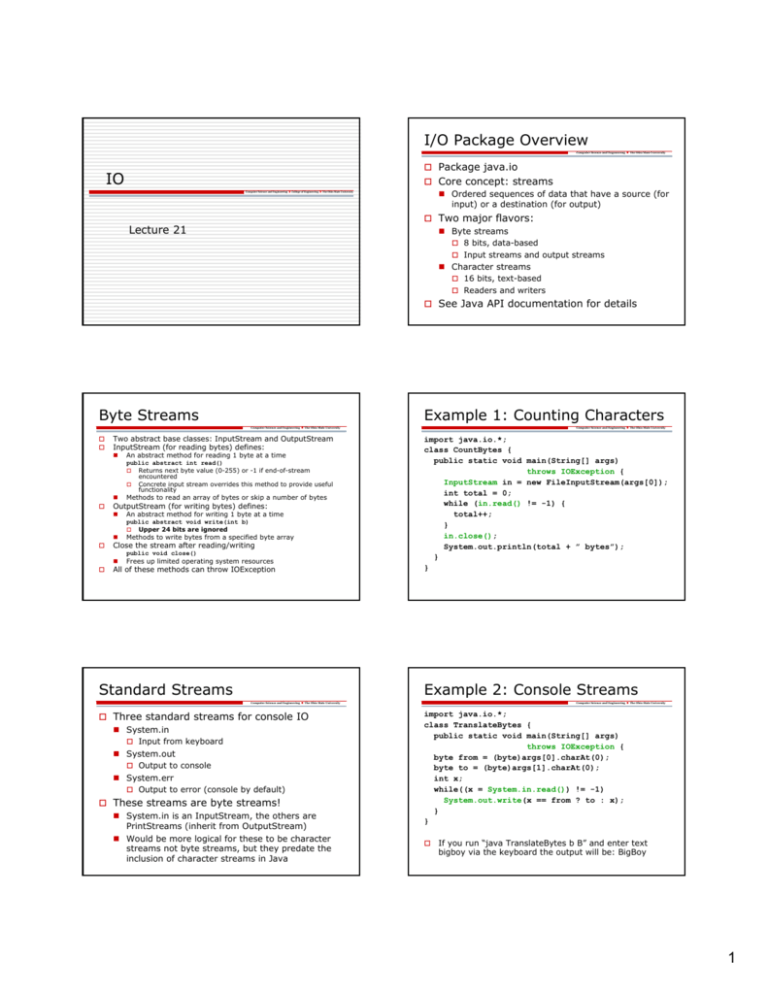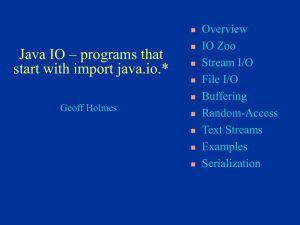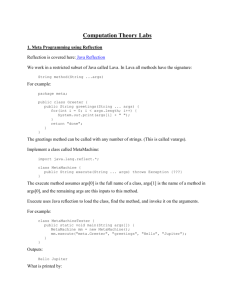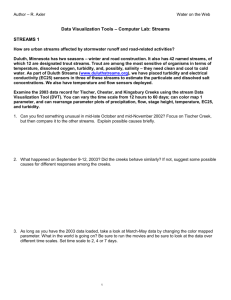slides
advertisement

I/O Package Overview
Computer Science and Engineering The Ohio State University
Package java.io
IO
Computer Science and Engineering College of Engineering The Ohio State University
Core concept: streams
Ordered sequences of data that have a source (for
input) or a destination (for output)
Two major flavors:
Byte streams
Lecture 21
8 bits, data-based
Input streams and output streams
Character streams
16 bits, text-based
Readers and writers
See Java API documentation for details
Byte Streams
Example 1: Counting Characters
Computer Science and Engineering The Ohio State University
Two abstract base classes: InputStream and OutputStream
InputStream (for reading bytes) defines:
An abstract method for reading 1 byte at a time
public abstract int read()
Returns next byte value (0-255) or -1 if end-of-stream
encountered
Concrete input stream overrides this method to provide useful
functionality
Methods to read an array of bytes or skip a number of bytes
An abstract method for writing 1 byte at a time
Methods to write bytes from a specified byte array
Frees up limited operating system resources
OutputStream (for writing bytes) defines:
public abstract void write(int b)
Upper 24 bits are ignored
Close the stream after reading/writing
public void close()
All of these methods can throw IOException
Standard Streams
Computer Science and Engineering The Ohio State University
import java.io.*;
class CountBytes {
public static void main(String[] args)
throws IOException {
InputStream in = new FileInputStream(args[0]);
int total = 0;
while (in.read() != -1) {
total++;
}
in.close();
System.out.println(total + ” bytes”);
}
}
Example 2: Console Streams
Computer Science and Engineering The Ohio State University
Three standard streams for console IO
System.in
Input from keyboard
System.out
Output to console
System.err
Output to error (console by default)
These streams are byte streams!
System.in is an InputStream, the others are
PrintStreams (inherit from OutputStream)
Would be more logical for these to be character
streams not byte streams, but they predate the
inclusion of character streams in Java
Computer Science and Engineering The Ohio State University
import java.io.*;
class TranslateBytes {
public static void main(String[] args)
throws IOException {
byte from = (byte)args[0].charAt(0);
byte to = (byte)args[1].charAt(0);
int x;
while((x = System.in.read()) != -1)
System.out.write(x == from ? to : x);
}
}
If you run “java TranslateBytes b B” and enter text
bigboy via the keyboard the output will be: BigBoy
1
Character Streams
Converting Byte/Character Streams
Computer Science and Engineering The Ohio State University
Two abstract base classes: Reader and Writer
Similar methods to byte stream counterparts
Reader abstract class defines:
Computer Science and Engineering The Ohio State University
Translation supported by conversion streams:
InputStreamReader and OutputStreamWriter
InputStreamReader
public int read(char[] cbuf)
public void skip(int n)
Writer abstract class defines:
An encoding is a standard map of characters to bits (eg UTF-16)
Reads bytes from associated InputStream and converts them to
characters using the appropriate encoding for that stream
OutputStreamWriter
public OutputStreamWriter(OutputStream out)
public OutputStreamWriter(OutputStream out, String enc)
public void write(int c)
public void write(int c)
public void write(char[] cbuf)
public abstract void flush()
Ensures previous writes have been sent to destination
Useful for buffered streams
Both classes define:
public int read()
Returns number of characters read
Subclasses of Reader and Writer respectively
public InputStreamReader(InputStream in)
public InputStreamReader(InputStream in, String encoding)
Returns value in range 0..65535 (or -1)
public int read()
Converts argument to bytes using the appropriate encoding and
writes these bytes to its associated OutputStream
Closing the conversion stream also closes the associated byte
stream – may not always desirable
public void close()
Working with Files
Efficient IO
Computer Science and Engineering The Ohio State University
A file can be identified in one of three ways
A String object (file name)
A File object
A FileDescriptor object
Sequential-Access file: read/write at end of stream only
FileInputStream, FileOutputStream, FileReader,
FileWriter
Each file stream type has three constructors
Random-Access file: read/write at a specified location
RandomAccessFile
A file pointer is used to guide the starting position
Not a subclass of any of the four basic IO classes
(InputStream, OutputStream, Reader, or Writer)
Computer Science and Engineering The Ohio State University
Buffering greatly improves IO performance
Example: BufferedReader for character input
streams
public BufferedReader(Reader in)
The buffered stream “wraps” the unbuffered
stream
Example declarations of BufferedReaders
An InputStreamReader inside a BufferedReader
Reader r = new InputStreamReader(System.in);
BufferedReader in = new BufferedReader(r);
A FileReader inside a BufferedReader
Reader fr = new FileReader(“fileName”);
BufferedReader in = new BufferedReader(fr);
Then you can invoke in.readLine() to read from
the stream line by line
Supports both input and output
Supports both bytes and characters
Example: A Random Access File
The File Class
Computer Science and Engineering The Ohio State University
class Filecopy {
public static void main(String args[]) {
RandomAccessFile fh1 = null;
RandomAccessFile fh2 = null;
try {
fh1 = new RandomAccessFile(args[0], “r”);
fh2 = new RandomAccessFile(args[1], “rw”);
} catch (FileNotFoundException e) {
System.out.println(“File not found”);
System.exit(100);
}
try {
int bufsize = (int) (fh1.length())/2;
byte[] buffer1 = new byte[bufsize];
fh1.readFully(buffer1, 0, bufsize);
fh2.write(buffer1, 0, bufsize);
} catch (IOException e) {
System.out.println("IO error occurred!");
System.exit(200);
}
}
}
Computer Science and Engineering The Ohio State University
Useful for retrieving information about a file or a
directory
Represents a path, not necessarily an underlying file
Does not open/close files or provide file-processing
capabilities
Three constructors
public File(String name)
public File(String pathToName, String name)
public File(File directory, String name)
Main methods
boolean canRead() / boolean canWrite()
boolean exists()
boolean isFile() / boolean isDirectory()
String getAbsolutePath() / String getPath()
String getParent()
String getName()
long length()
long lastModified()
2
Example
Computer Science and Engineering The Ohio State University
public class EfficientReader {
public static void main (String[] args) {
try {
Reader fr = new FileReader(args[0]);
BufferedReader br = new BufferedReader(fr)
String line = br.readLine();
while (line != null) {
System.out.println("Read a line:");
System.out.println(line);
line = br.readLine();
}
br.close();
} catch(FileNotFoundException e) {
System.out.println(“File not found: ” + args[0]);
} catch(IOException e) {
System.out.println(“Can’t read from file: ” + args[0]);
}
}
}
3








